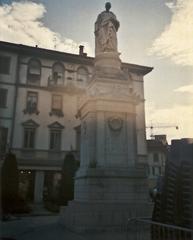
Como–Cantù–Asnago Tramway: Visiting Hours, Tickets, and Historical Significance Guide
Date: 04/07/2025
Introduction
The Como–Cantù–Asnago Tramway stands as a remarkable testament to Lombardy’s early 20th-century transportation evolution. This electric tramway, inaugurated in the early 1900s, connected the lakeside city of Como with the industrious towns of Cantù and Asnago. By replacing horse-drawn carriages and streamlining both passenger and freight movement, it played a pivotal role in the region’s economic and social growth. Though its tracks were lifted by the mid-20th century, the tramway’s legacy endures in the area’s infrastructure, museums, and community memory, offering visitors today a unique window into the past (Treniebinari.it; Wikimedia Commons; Museo del Mobile; Como Tourism).
Table of Contents
- Introduction
- History of the Como–Cantù–Asnago Tramway
- Tramway Legacy and Heritage Today
- Visiting the Tramway Area
- Frequently Asked Questions (FAQs)
- Visuals and Media Suggestions
- Further Resources and Useful Links
- Summary and Visitor Recommendations
History of the Como–Cantù–Asnago Tramway
Origins and Technical Features
The tramway was inaugurated in 1907, reflecting Lombardy’s modernization through electric transport. Constructed on a 1000 mm metric gauge and electrified at 600 V DC, it replaced earlier horse-drawn systems, providing efficient and reliable urban and interurban connections (Treniebinari.it). The route began in Como and extended to Cantù and Asnago, ultimately linking with the Milan–Chiasso railway, enabling seamless travel and goods movement.
Expansion and Operation
Over the decades, the tramway saw several operators—SATEC, SECAV, and STECAV—who improved the network and increased its reach. Single-track lines with passing loops and comfortable, purpose-built tramcars made the system suitable for both passengers and light freight. The tramway became essential to daily life, particularly for workers in Cantù’s renowned furniture and textile industries.
Socio-Economic Impact
By facilitating swift travel and cargo transport, the tramway was a catalyst for economic development and urban expansion. It supported Cantù’s rise as a furniture-making hub, allowed for greater workforce mobility, and encouraged the integration of rural communities into the regional economy.
Decline and Closure
The proliferation of private vehicles and bus lines in the 1930s marked the tramway’s gradual decline. The Cantù–Asnago section closed in 1934, with the remainder ceasing operations in 1951. The shift toward buses and cars ultimately rendered the tramway obsolete, though its impact is still visible in the urban fabric (Treniebinari.it).
Tramway Legacy and Heritage Today
Surviving Infrastructure and Signage
Remnants of the tramway are still accessible:
- Historic Bridges and Tracks: The old tramway bridge near Cantù Asnago, now reserved for pedestrians and cyclists, serves as a tangible link to the past. Adjacent to this is the modern bridge, completed in 2025, underscoring the route’s ongoing importance (La Provincia di Como; ComoZero).
- Station Buildings: While many have been repurposed or demolished, some architectural features remain recognizable.
- Interpretive Signage: Local authorities and historical societies have installed plaques and displays marking points of interest along the old route, especially in Cantù and Asnago.
Museums and Exhibitions
- Museo del Mobile (Cantù): Features exhibits on the tramway’s role in supporting the furniture industry (Museo del Mobile).
- Local Historical Societies: Occasionally organize exhibitions and special events focused on the tramway.
- Archival Images: Wikimedia Commons offers a digital collection of historic photographs.
Visiting the Tramway Area
Accessibility and Practical Information
- No Tickets Required: The tramway remnants are freely accessible year-round during daylight hours.
- Accessible Routes: The Cantù Asnago area is flat and suitable for visitors with reduced mobility. The new and old bridges are wheelchair-friendly, and cycling paths are well maintained (Lake Como Travel).
- Getting There:
How to Visit: Walking, Cycling, and Self-Guided Tours
- Walking/Cycling: The former tramway corridor is best explored on foot or by bike. The old bridge provides a scenic, historically significant path between Cantù and Asnago, connecting to broader cycling and pedestrian networks (La Provincia di Como).
- Self-Guided Heritage Walks: Maps and resources are available at local tourist offices (ViaMichelin).
- Guided Tours: Occasionally available during festivals and special events—check with Cantù and Como tourism offices for updates.
Visiting Hours and Tickets
- Museums:
- Museo del Mobile: Tuesday–Sunday, 9:00 AM–6:00 PM; tickets approximately €8, with discounts for seniors and students.
- Other museums may feature related exhibitions—verify details on their official websites.
- Tramway Remnants: Open access, no ticket needed, daylight hours.
Events and Community Life
- Festivals: Cantù’s patron saint festival in September and summer fairs often include heritage walks and tramway displays (Terre da Mare).
- Local Cuisine: Sample regional specialties such as cheeses, polenta taragna, and risotto alla canturina at nearby restaurants.
Nearby Attractions
- Basilica of Galliano: A significant historical site close to the tramway route (Terre da Mare).
- Como’s Lakefront and Funicular: Popular destinations that can be combined with a tramway heritage walk.
- Cantù’s Town Center and Art Gallery: Offer cultural context and complement the tramway experience.
Frequently Asked Questions (FAQs)
Q: Are there visiting hours or tickets required to see the tramway remnants?
A: No, the tramway remnants are open to the public free of charge during daylight hours.
Q: Is there a museum dedicated to the Como–Cantù–Asnago Tramway?
A: There is no dedicated tramway museum, but the Museo del Mobile and local historical societies provide related exhibitions.
Q: How accessible is the area for visitors with reduced mobility?
A: The area is flat and accessible, with pedestrian-friendly paths and modern facilities.
Q: What is the best time of year to visit?
A: Spring and early autumn are ideal for pleasant weather, while local festivals in summer and autumn offer additional cultural experiences.
Q: Are guided tours available?
A: Guided heritage walks are occasionally scheduled during festivals; check with tourism offices for dates.
Visuals and Media Suggestions
- Photos: Historic and contemporary images of tramway bridges, stations, and interpretive signage.
- Maps: Highlighting the former tramway route and current walking/cycling paths.
- Event Photos: Scenes from local festivals and heritage walks.
- Infographics: Depicting the tramway’s impact on regional development.
Alt text examples: “Historic tramway bridge Cantù,” “Como–Cantù–Asnago Tramway visiting,” “Cantù historical sites.”
Further Resources and Useful Links
- Treniebinari.it - Lombardy Tramways
- Wikimedia Commons: Tram Transport in Como
- Museo del Mobile - Cantù
- Como Tourism Official Site
- Terre da Mare - Cantù
- La Provincia di Como: Cantù Asnago Bridge News
- ComoZero: Infrastructure Developments
- Rome2Rio: Como–Cantù Transport
- Lake Como Travel Guide
Summary and Visitor Recommendations
The Como–Cantù–Asnago Tramway, though no longer operational, lives on as a vital cultural and historical landmark of Lombardy’s industrial age. It revolutionized local transport, supported economic growth, and fostered community connections. Today, its legacy is honored through preserved bridges, interpretive signage, museum exhibits, and community celebrations. Visitors are encouraged to explore the route via self-guided walks or cycling, experience local culture at nearby attractions, and participate in festivals and guided tours when available. For up-to-date information, consult official tourism sites and local resources.
Embrace the Como–Cantù–Asnago Tramway’s story to gain unique insight into the evolution of Lombardy’s society and infrastructure. Start planning your journey today to discover the region’s fascinating history and vibrant culture (Treniebinari.it; La Provincia di Como; ComoZero).










